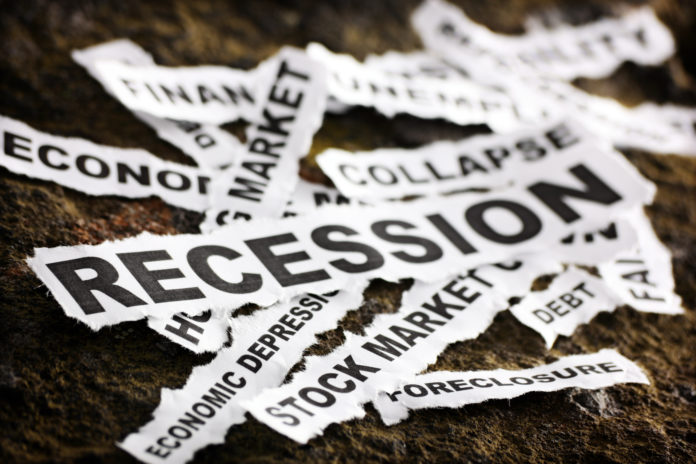It is hard to argue that Americans are not struggling in this economy, but politicians and the mainstream media are certainly trying. Sitting atop their ivory towers, Wall Street propagandists tout labor market misinformation to paint America’s decline as an economic recovery. This calloused view, is a contagious symptom of a larger financial epidemic, which ignores conclusive evidence that suggests the United States is on the verge of entering a dark period of economic pain — worse than what consumers have already experienced with record high inflation.
In the first quarter of 2022, real Gross Domestic Product (GDP) from the St. Louis Federal Reserve fell by a rate of 1.4% due to the United States recording a historic trade deficit as imports increased nearly 18% while exports decreased more than 5%. Economists foolishly touted that the trade deficit was financial noise and not to be taken too seriously and used this as further evidence that the country was not heading toward a recession. While the media was quick to dismiss the troubling GDP report, they joined the chorus of misinformation to say that inflation also reached a peak.
Additionally, while the Biden administration spins tales about monthly job reports, Nela Richardson, the Chief Economist at ADP poured cold water on the administration’s claims that they are responsible for creating new jobs. The fact of the matter, as Richardson noted, is that the increase in labor market activity is due to jobs being recovered, not created. As a guest on CNBC, Richardson stated that the economy “hasn’t added one single job from the 2019 high water mark.” The 2019 high water mark is a reference to the record low unemployment and strong labor market conditions experienced during the previous Trump administration. She went on to say, “All the jobs that we have seen gain are recovered jobs that we lost. We are not producing new jobs…so these wage gains are coming on top of a shrinking workforce, and it’s not being fueled by productivity enhancements.”
To those who believe that the economy is recovering, the consensus is clear — it is not. Food and energy shortages are causing complications for consumers as the price of gas seemingly sets a new record every day, and many food prices are up over double-digits in the latest Consumer Price Index report. Although consumer spending increased in the face of high inflation, this trend will soon reverse itself. Former Chief Economist for the Securities and Exchange Commission, Larry Harris, said to CNBC that it would be exceedingly difficult for the Federal Reserve to fight inflation without causing a recession in the process. Even if the Fed were to avoid a recession, it is even more likely that it will be caused by consumers repurposing their spending.
Gas prices reached a new record of $4.91 on June 7th, which is 60% more expensive than in 2021 when gas prices were $3.06 and 136% more expensive than May of 2020 when the price of a gallon of gas was $2.08. Labor costs are also increasing throughout the United States as there are more jobs available than unemployed to fill them, and since wage increases can’t keep up with the high rate of inflation, Americans are actually losing money. The logical argument suggests that if consumers’ purchasing power decreases while prices rise, the natural reaction from Americans would be to streamline their spending as much as possible to avoid racking up massive amounts of debt. Wall Street insiders and politicians have refused to acknowledge this rational view of microeconomics.
The same argument holds true from a macroeconomic perspective. Debt is a dead weight on a country and since the start of the pandemic, the American people have accumulated historic levels of debt. A rapid increase in housing costs forced homebuyers into more expensive mortgages as housing prices surged over 20% compared to prices in 2021, according to the CoreLogic Case-Shiller Home Price Index. Worse than the rising price for homes is the debt that comes with the home purchase. While prices have increased so have mortgage rates, which are now at 5% or more for a 30-year mortgage. The Washington Post recently reported on Americans who purchased new homes that were under construction, who signed contracts expecting one interest rate for their mortgage and are now facing a rate that is 40- to 50% higher due to rising interest rates.
To make matters worse, while rates and prices continue to rise, the demand for housing plummeted over 16% causing economists to become fearful of a massive housing market bubble burst, adding more financial obstacles to an already troubled economy. Additionally, as the Federal Reserve embarks on their interest rate hike campaign — and subsequent tightening of their balance sheets — credit cards and other variable forms of debt are becoming more expensive for consumers to finance, which presents a dangerous situation that could lead to a wave of financial defaults in the short to medium term. A recent report indicated that for every basis point that the Federal Reserve raises interest rates, it adds one extra dollar to every $10,000 in debt. For example, if the Fed reaches 2% interest rates before the end of 2022 — a 200-basis point increase —this would add an additional $200 in interest on every $10,000 of debt.
Rising interest rates also have an adverse effect on the stock market and at-risk investors have lost approximately $5- to $8 trillion dollars in response to volatility on Wall Street as a result of recent economic problems and the threat of a recession. Ultimately, Americans are being financially ambushed from all fronts and the consensus is clear, the only path forward is through a deep economic recession. While politicians and Wall Street media insiders focus on pulling the wool over the eyes of at-risk American investors, the reality is that food and energy shortages, crippling inflation, and an incredibly poor stock market performance has forced the economy into a nosedive towards a financial collapse.













